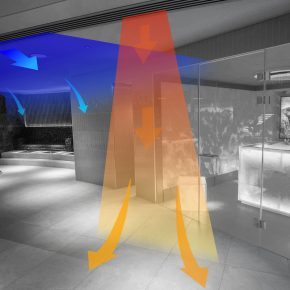
How augmented reality can change how we design, build and manage
GUEST BLOG: Kaan Aydogmus, founder of multi-disciplinary design agency Magnetic London.
The days of pencil sketches and paper plans are long in the past. Traditional design and construction methods have been replaced by smart computer-aided design and virtual 3D models.
And since the advent of Building Information Management (BIM), the construction industry has been constantly searching for new ways to enhance and improve how we approach the design, building and management of a project.
In recent years, augmented reality has entered this space, and some firms have already reaped the benefits of incorporating this intelligent tech into their work.
What is augmented reality?
Augmented reality bridges the gap between print and digital. Two-dimensional designs can be transformed into interactive 3D models simply by scanning a drawing, label or image with a smartphone or tablet loaded with an augmented reality app.
Unlike virtual reality, which is a far more complex and expensive technology requiring a headset, augmented reality has a much wider scope for use in everyday activities and business. It is a flexible technology that can be adapted to an infinite number of tasks. And thanks to widespread smartphone use and increasingly advanced mobile software, it’s available to almost everyone.
How can augmented reality aid construction?
Augmented reality has a place in all aspects of construction. It can help architects communicate their plans, guide construction workers through the building process and allow clients to see the real-time progress of a project. AR can completely change the way we engage with the design and completion of a project by allowing users to conceptualise and interpret designs in a new way.
Augmented reality apps can bring 2D blueprints ‘to life’. When scanned with a smartphone, you could view a 3D digital overlay, showing exactly how a space should look in the real-life surrounding environment.
360-degree visuals can help architects effectively communicate their design ideas. Many people find it difficult to digest 2D plans – 3D renderings are much easier to understand as users can see how all the elements come together. Blueprints often only make sense to the architect who knows how to interpret them.
Augmented reality goes hand-in-hand with BIM, taking these information-rich virtual models and superimposing them onto the real world, in real time, when users hold up their smartphone.
Safety is a primary concern during construction. Augmented signs could be placed throughout a construction site which, when scanned, could take users through safety procedures.
How is augmented reality already being used in the construction industry?
In recent years The Institute for Systems Biology employed augmented reality to manage the renovation of their new headquarters, completed in 2011.
Builders placed augmented signs throughout the building which, when scanned, provided 3D renderings of the various design elements and showed where different building components should be installed.
Augmented reality was also used for the construction of the new Kaiser Permanente Oakland Medical Centre – one of the largest implementations of this technology for a US construction project. Markers were placed on the doorjamb of each room, allowing architects and contractors to immerse themselves in a full-size virtual model of each space.
This simple use of augmented reality quickly delivered up-to-date information on the project’s progression, eliminating the need for workers to run back and forth from their computer, saving a huge amount of time.
What is the potential for augmented reality?
The implementation of augmented reality to aid the management of construction projects, from planning to completion, is still in the early stages.
Therefore, there are still some limitations to the technology. Smartphones and tablets are not as intelligent as a desktop computer, therefore augmented reality apps must work within certain parameters. For example, this means complex architectural models, which contain huge amounts of information such as lighting and finishing details, must be simplified.
The use of augmented reality in the construction industry has a long way to go and applications require further development before mainstream adoption of this technology. Yet even in it’s infancy, augmented reality has proven to be a useful tool and presents a significant opportunity for the future of the construction industry.
Latest news

2nd April 2025
FIT Show 2025 Launches Innovative Marketplace Feature to Enhancing Value for Installers
FIT Show, the UK’s leading event for the window, door, flat glass, hardware, and roofing industries, is excited to announce the launch of a brand new Marketplace feature at its upcoming 2025 event (Birmingham NEC, 29 April – 1 May).
Posted in Architectural Ironmongery, Articles, Building Industry Events, Building Industry News, Building Products & Structures, Doors, Exhibitions and Conferences, Glass, Glazing, Hand Tools, Innovations & New Products, Plant, Equipment and Hire, Power Tools, Restoration & Refurbishment, Retrofit & Renovation, Roofs, Seminars, Training, Windows
2nd April 2025
Hi-spec deployment of EJOT Colorfast at new Birmingham logistics park
EJOT Colorfast fasteners have been used extensively in the construction of eight new high-specification warehousing and logistics buildings at the Urban 8 Logistics Park in King’s Norton, Birmingham.
Posted in Articles, Building Industry News, Building Products & Structures, Building Systems, Case Studies, Facades, Restoration & Refurbishment, Retrofit & Renovation, Roofs, Walls
2nd April 2025
SWA member delivers ‘fresh Hope’ for university’s Sustainable Building department
A detailed contract to restore an iconic Art Deco building in the heart of Birmingham’s Jewellery Quarter was carried out by Steel Window Association member, The Window Repair Company (Northwest) Limited.
Posted in Articles, Building Associations & Institutes, Building Industry News, Building Products & Structures, Building Systems, Case Studies, Glass, Glazing, Restoration & Refurbishment, Retrofit & Renovation, Steel and Structural Frames, Sustainability & Energy Efficiency, Windows
1st April 2025
Gilberts Takes Thermal Comfort to New Heights
Gilberts Blackpool is continuing to build on its reputation as a pioneer with the unveiling of ThermaAstute™ – the most extensive range of thermally sensitive diffusers in the market.
Posted in Air Conditioning, Articles, Building Industry News, Building Products & Structures, Building Services, Facility Management & Building Services, Heating, Ventilation and Air Conditioning - HVAC, Innovations & New Products, Restoration & Refurbishment, Retrofit & Renovation, Sustainability & Energy Efficiency
 Sign up:
Sign up: